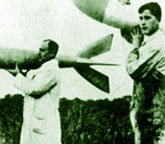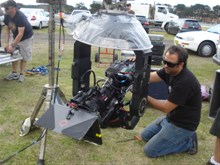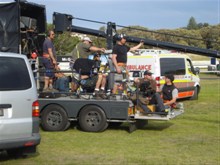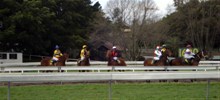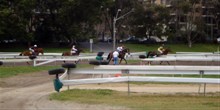|
Date:
23rd August 2012, 5:00am - 5:30pm
Location: Kurnell, Randwick Race
course, NSW, Australia
Conditions:
20 - 40km/h very windy, warm
25C, partly cloudy in the morning, overcast
and stormy later
Team Members at Event:
PK and
GK
TV Commercial
Last week our rocketry club (NSWRA) was
approached by an advertising agency filming
a TV commercial here in Sydney that involved
a father and son building and launching a
water rocket. They had the actors but needed
some water rockets and a launcher. So we
agreed on a design with a couple of options
that would work for them. In order to
simplify the whole shoot it was decided that
no recovery system would be used. They were
aware that the rocket would be destroyed
after just one flight so they ordered 5 of
them. They were on a tight schedule and we
only had several days to get them all ready.
The design was based on the
Axion II rocket.
Luckily we had enough parts and bottles to
make up the required rockets. I think we ended
up using close to 80 x 1.25L bottles on the
actual rockets and spare parts.
The rockets
Each rocket consisted of 2 spliced pairs
and a single bottle to give a total volume
of around 5.45L. These were coupled together
with normal Tornado tubes with the holes
enlarged and custom washers fitted. The
rockets also had coriflute fins. The
nosecone was just an empty bottle with half
a ping pong ball for the tip. We also taped
an old C- battery onto the top bottle for
extra ballast. These batteries weighed 68
grams. The whole nosecone was just spray
painted red. Initially they asked for the
fins to be painted silver, but the day
before the shoot they asked if they could be
painted red instead and so we re-sprayed
them red. The entire rocket weighed
approximately 450 grams.
We also prepared 3 parachute nosecones
just in case they decided that they wanted
parachutes on the day.
We ended up making 5 rockets + 1 spare.
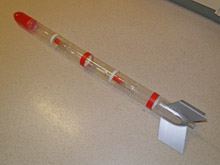 |
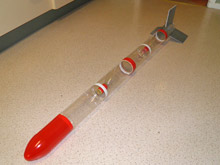 |
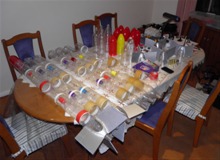 |
Paint scheme as originally
requested |
Front view. There is
no recovery system |
Preparing all the rockets a
couple
of nights before. |
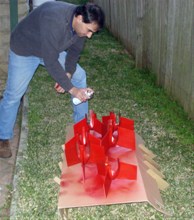 |
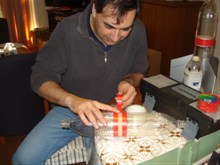 |
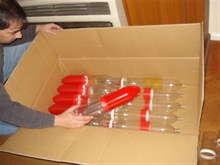 |
Last minute
re-spraying fins. |
Instead of painting we wrapped
the splices with red electrical
tape |
All neatly staked in a box. |
The launcher
Initially they asked to use our old green
launcher, but dad and I also modified our
medium launcher to make it look a little
more home made with a couple of wooden
planks for the base. we also added the guide
rails from our old green launcher so that it
didn't look too complicated. On the day they
decided to use the medium launcher which was
a better choice because it was more stable
than the old launcher especially with the
taller rockets. Normally the small launcher
wouldn't be an issue because we pin it to
the ground with tent pegs, but because they
were shooting on the rocky headland there
was nowhere to hammer the pins in.
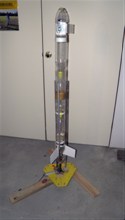 |
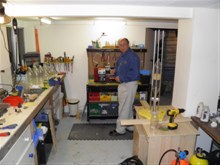 |
The medium
launcher that
was used for the shoot. |
Here is the
medium launcher
being worked on. |
Launch day
This was definitely our earliest start
for a launch to date. We got up just after
3am so we could drive about 1 hour to be on
location by 5am. The nice thing was that
there were no cars on the road at that time.
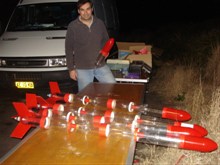 |
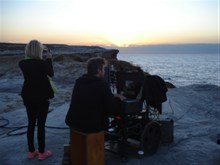 |
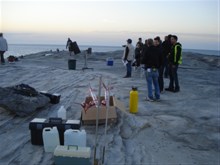 |
| 5am Start. It
was pitch black. |
Sunrise on
location
at the headland. |
Waiting for
some other scenes
to be filmed. |
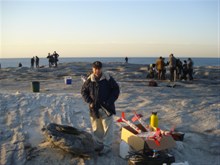 |
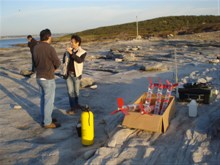 |
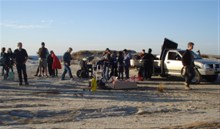 |
| We started
off with nice blue skies |
but pretty
windy |
getting ready
to set up the rockets |
Due to the location being directly under
the approach flight path to Sydney airport,
we had to restrict the altitude of the
rockets. Since the actors were going to be
close to the rockets anyway we only used
lower pressures.
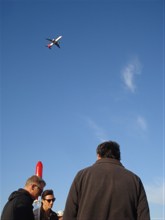 |
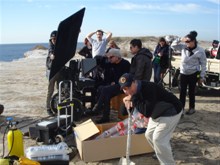 |
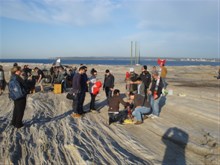 |
| Right under
the flight path. |
Dad working
hard as always |
Deciding on
how the scene will work |
The other major problem was the very
strong breeze blowing out to sea. We knew we
may loose a few of the rockets in the ocean.
This really didn't matter as they were one
flight rockets anyway.
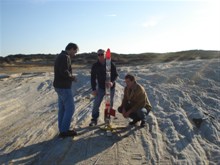 |
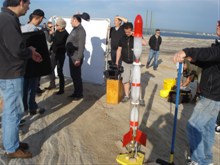 |
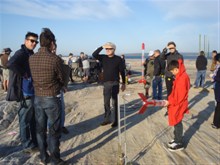 |
| Rocket set up
on the pad |
For quick set up the rockets
were
pre-filled with water and foam. |
Director
deciding how the scene will
play out. |
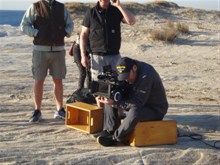 |
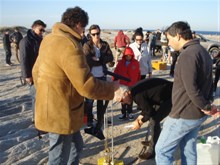 |
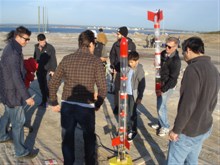 |
| One of the
camera men. |
|
Spare rockets
ready for launch |
They first did several takes of the
father and son setting up the rocket. After
that they managed to get 2 launches in
before the crew had to move on to another
nearby location. Although there is a foot
pump in the scene, it was never used as it
would have taken too long to pump up the
rockets by hand. We remotely pressurised the
rockets from the scuba tank. The hose was
buried under some sand so you couldn't see
it.
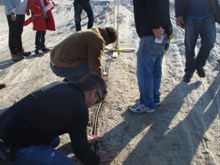 |
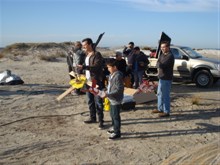 |
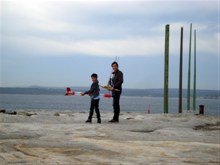 |
Burying the
hose to the
scuba tank. |
"Father and
son" |
|
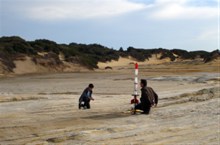 |
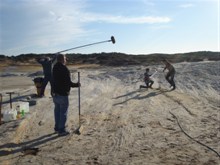 |
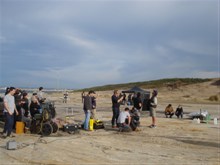 |
|
"Action" |
|
The first rocket flew well and came down
about 30 meters off the edge of the cliff
and on the rocks below. The second rocket
had a similar flight but the wind blew it
further out and it landed in the ocean. One
of the crew managed to retrieve both of them
later when the second one washed up on the
rocks.
We always had to wait with each launch
until there were no planes coming in for a
landing.
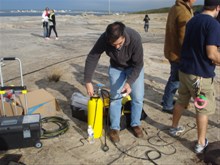 |
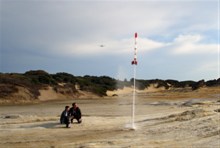 |
| Remotely
pressurising the rocket |
Waiting until
the plane goes past...
... and launch. |
Then we packed up the gear and headed
back to unit base for lunch (The catering
was awesome!) while they filmed some more
scenes with the father and son getting the
rocket out of a car and arriving at the
launch site. They wanted to get some more
shots of the rockets going up into the sky,
so we set them up at the local park near
where we had lunch, but
weren't sure if they would get through all
their other scenes before filming the
rockets.
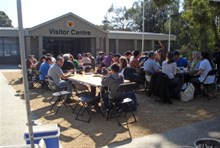 |
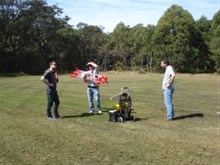 |
| Lunch with
the crew. |
Waiting at
the local park to see if
they were going to film some
more. |
So after 2 hours of waiting we packed up
and headed to another location at the
Randwick (horse) race course where they were
going to be filming horses racing. They
rented out the whole race track!
We set the rockets up in the middle
of the track ready for filming should they get a
chance. Finally at about 5:00pm they had an
opportunity to film the rockets in flight so we
launched one with foam using the Jet foaming
spacer and a second one without. The light
was fading fast though as a storm was
approaching so I'm not sure if they'll be
able to use that footage or not. Both
rockets flew great and also nicely crumpled
on impact. The wind was still blowing hard
at around 30-40km/h. Way too strong for what
we would normally launch in.
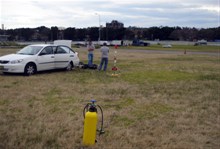 |
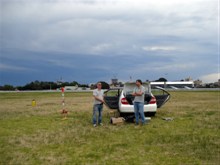 |
| Waiting for
the film crew ... |
... as a
storm approaches. |
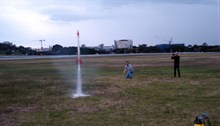 |
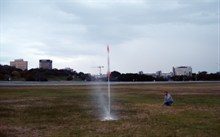 |
| Launch with
jet foaming spacer |
Regular
launch at twilight |
I don't think we will get many more
opportunities to launch our water rockets right in
the middle of the Randwick race course. Just as we
finished packing up the last of the rockets
a huge storm came through with lightning and
even stronger wind so we all went home. It was a
long day, but a lot of fun with a very
friendly crew, and it was good to see
what all goes on behind the scenes of a
commercial shoot.
When the commercial is finished, and if
it's available on line I will post a link to
it here and also mention who the client was.
Servo Timer IIs
We've been busy over the last couple of
weeks soldering up more of the Servo Timer IIs. As we are making these in a greater
quantity this time, we were able to get
better volume discounts on the components so
the timers are a little cheaper than last
time.
If you are interested in using one, they
can be purchased here:
Servo
Timer II
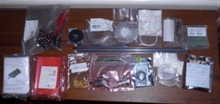 |
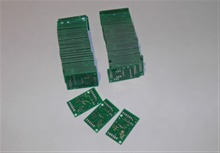 |
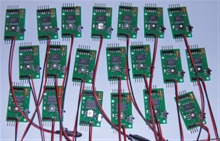 |
| Components
from Digikey have arrived |
ST II PCBs |
ST IIs ready
for testing |
Centrifuge
In testing of the timers we
noticed that some G-switches need more
acceleration than others to activate. The
specification says that they activate
between 2 and 4.9G. 5G may be difficult to
achieve on rockets using small nozzles and
foam or low pressures. So in order to
characterise the G-switches we built a
little centrifuge so we could see at what
G-forces the G-switches actually activate.
The centrifuge was built using the kids Lego Mindstorms NXT
2.0 kit. It made it easy to build
and control the speed of the spinning arm.
The test circuit simply consisted of a 9V
battery an LED and a resistor hooked up to a
socket so we could plug the G-switches into
it easily.
The distance of the G-switch from the center
could also be adjusted to vary the acceleration
force.
We used the high-speed camera to measure
the actual speed of the spinning arm. We
weren't looking for specific activation
force, but more at the relative distribution
of the activation forces for the G-switches
if they were roughly the same or whether
they varied widely.
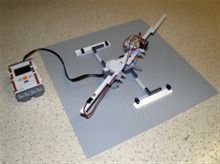 |
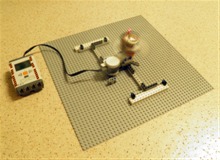 |
Centrifuge for testing G-switch
activation force |
Centrifuge in operation |
Flight Details
| Launch |
Details |
|
Location: Kurnell |
| 1 |
|
Rocket |
|
Axion II |
|
Pressure |
|
80psi |
|
Nozzle |
|
9mm |
|
Water |
|
800mL + foam |
|
Flight Computer |
|
None |
|
Payload |
|
None |
|
Altitude / Time |
|
? / ? |
|
Notes |
|
Good flight with
crash landing as intended. No
recovery system used. |
|
| 2 |
|
Rocket |
|
Axion II |
|
Pressure |
|
80psi |
|
Nozzle |
|
9mm |
|
Water |
|
800mL + foam |
|
Flight Computer |
|
None |
|
Payload |
|
None |
|
Altitude / Time |
|
? / ? |
|
Notes |
|
Good flight with
crash landing as intended. No
recovery system used. |
|
|
Location: Randwick Race Course |
| 3 |
|
Rocket |
|
Axion II |
|
Pressure |
|
100psi |
|
Nozzle |
|
9mm |
|
Water |
|
1000mL + foam |
|
Flight Computer |
|
None |
|
Payload |
|
None |
|
Altitude / Time |
|
? / ? |
|
Notes |
|
Good flight with
crash landing as intended. No
recovery system used. This rocket
had a smaller lowest bottle and
equipped with jet foaming spacer.
Nice slow take-off. |
|
| 4 |
|
Rocket |
|
Axion II |
|
Pressure |
|
90psi |
|
Nozzle |
|
9mm |
|
Water |
|
800mL + foam |
|
Flight Computer |
|
None |
|
Payload |
|
None |
|
Altitude / Time |
|
? / ? |
|
Notes |
|
Good flight with
crash landing as intended. No
recovery system used. |
|
|


